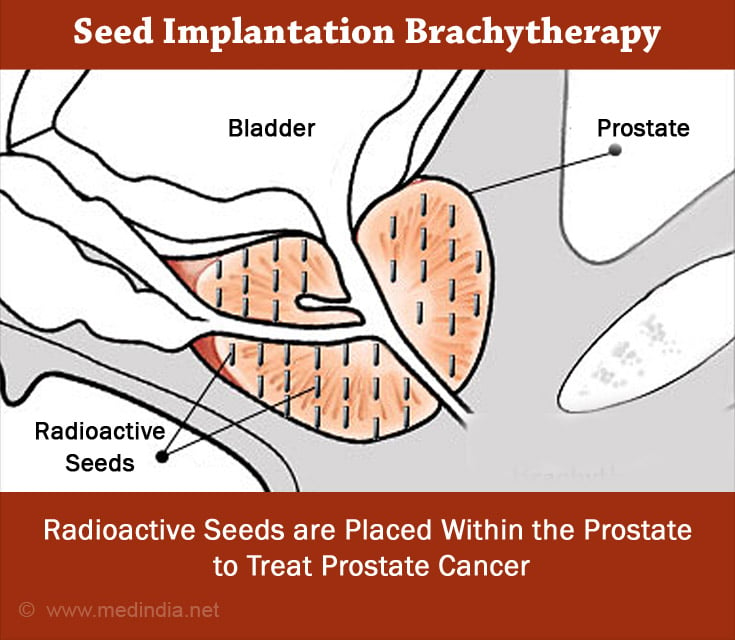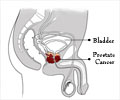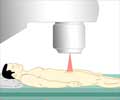- Current Status of Brachytherapy for Prostate Cancer - (https://www.ncbi.nlm.nih.gov/pmc/articles/PMC3502731/)
- Brachytherapy - (https://www.ncbi.nlm.nih.gov/books/NBK562190/)
- Low-dose-rate or high-dose-rate brachytherapy in treatment of prostate cancer – between options - (https://www.ncbi.nlm.nih.gov/pmc/articles/PMC3635047/)
- Brachytherapy in the therapy of prostate cancer – an interesting choice - (https://www.ncbi.nlm.nih.gov/pmc/articles/PMC3934024/)
- Anaesthesia for brachytherapy - (https://pubmed.ncbi.nlm.nih.gov/18660663/)
- Permanent interstitial low-dose-rate brachytherapy for patients with localised prostate cancer: a systematic review of randomised and nonrandomised controlled clinical trials - (https://pubmed.ncbi.nlm.nih.gov/21763066/)
- Iodine-125 and Palladium-103 Low Dose Rate Brachytherapy Seeds Used for Localization of Non-Palpable Lesions - (https://www.nrc.gov/materials/miau/med-use-toolkit/seed-localization.html)
- Brachytherapy as a treatment option for prostate cancer: overview and nursing considerations - (https://www.ncbi.nlm.nih.gov/pmc/articles/PMC1317044/)
- Iodine-125 seed brachytherapy for early stage prostate cancer: a single-institution review - (https://www.ncbi.nlm.nih.gov/pmc/articles/PMC4349732/)
- Radiotherapy: Basic Concepts and Recent Advances - (https://www.ncbi.nlm.nih.gov/pmc/articles/PMC4920949/)
- The American College of Radiology and the American Brachytherapy Society practice parameter for the performance of radionuclide-based high-dose-rate brachytherapy - (https://pubmed.ncbi.nlm.nih.gov/28109634/)
- Brachytherapy in the treatment of cervical cancer: a review - (https://www.ncbi.nlm.nih.gov/pmc/articles/PMC4045176/)
- Timing of High-Dose Rate Brachytherapy With External Beam Radiotherapy in Intermediate and High-Risk Localized Prostate Cancer (THEPCA) Patients and Its Effects on Toxicity and Quality of Life: Protocol of a Randomized Feasibility Trial - (https://www.ncbi.nlm.nih.gov/pmc/articles/PMC4430680/)
- Highâ€doseâ€rate brachytherapy for prostate cancer: Rationale, current applications, and clinical outcome - (https://www.ncbi.nlm.nih.gov/pmc/articles/PMC8789612/)
- High dose rate brachytherapy as monotherapy for localised prostate cancer - (https://pubmed.ncbi.nlm.nih.gov/29074079/)
- HDR brachytherapy as monotherapy for prostate cancer: A systematic review with meta-analysis - (https://pubmed.ncbi.nlm.nih.gov/33461894/)
- Quality of life outcomes after brachytherapy for early stage prostate cancer - (https://pubmed.ncbi.nlm.nih.gov/10687991/)
- Urinary side effects and complications after permanent prostate brachytherapy: the MD Anderson Cancer Center experience - (https://pubmed.ncbi.nlm.nih.gov/19589580/)
- Management of sexual dysfunction after prostate brachytherapy - (https://pubmed.ncbi.nlm.nih.gov/12599931/)
- Less restrictive patient-specific radiation-safety precautions can be safely prescribed after permanent seed implantation - (https://www.ncbi.nlm.nih.gov/pmc/articles/PMC3819139/)
Prostate Brachytherapy
Brachytherapy is ideally suited for treatment of early prostate cancer and was first used as a treatment modality 60 years ago.
The American Joint Committee on Cancer (AJCC) defines a suitable candidate for brachytherapy as a prostate cancer patient whose cancer is in stage T1-T2, patient whose PSA (prostate specific antigen) levels are equal to or less than 10 ng/ml or the patient with a biopsy grade of Gleason score (a score to evaluate the prognosis of prostate cancer) lower than 7(1✔ ✔Trusted Source
Current Status of Brachytherapy for Prostate Cancer
Go to source).
What is Brachytherapy?
Brachytherapy refers to cancer treatment with ionising radiation delivered via radioactive material placed at a short distance from, or within, the tumor. It is also known as “Internal beam radiation therapy”. The term “brachy” is derived from the Greek word ”brachys”, which means brief or short(2✔ ✔Trusted Source
Brachytherapy
Go to source).
When do we need Brachytherapy?
Brachytherapy is used to treat cancers of the head and neck, breast, cervix, prostate, and eye. With high success rates, brachytherapy has gained popularity as the treatment option for prostate cancer.
How does Brachytherapy Work?
In brachytherapy seeds, ribbons, or capsules that contain a radiation source are placed in or near the tumour. The idea is for the radiation to work locally on the tumor cells and not so much on the surrounding normal tissue.
What are the Types of Brachytherapy used for Prostate Cancer?
Two types of brachytherapy are practised to treat prostate cancer: Permanent Low Dose Rate (LDR) Brachytherapy and Temporary High Dose Rate (HDR) Brachytherapy(3✔ ✔Trusted Source
Low-dose-rate or high-dose-rate brachytherapy in treatment of prostate cancer – between options
Go to source). However, additional management strategies like hormonal ablation or short exposure to external beam radiation may also be used in combination with brachytherapy.
Prostate cancer patients with a high risk of developing extension in the prostate can be considered for brachytherapy, but in combination with supplemental IMRT (intensity-modulated radiation therapy), which is a form of external beam radiotherapy (EBRT)(1✔ ✔Trusted Source
Current Status of Brachytherapy for Prostate Cancer
Go to source).
Brachytherapy is never considered for patients with prostate glands larger than 60 grams. However, Oncologists insists on brachytherapy in patients with gland sizes up to 60 g after downsizing them using hormonal ablation therapy.
The hormone therapy reduces the size of the gland by 25-40% and therefore aids in treating the patient with brachytherapy. However, according to a pilot study, patients undergoing hormone therapy for the gland are at high risk of developing acute urinary retention and dysuria (painful urination).
When Should Brachytherapy not be Used?
Brachytherapy is contraindicated in patients with the following conditions:
- Distant spread of prostate cancer(4✔ ✔Trusted Source
Brachytherapy in the therapy of prostate cancer – an interesting choice
Go to source) - Highobesity (layers of fat interfere with the insertion of a surgical probe or needle)
- Life expectancy of less than 5 years(5✔ ✔Trusted Source
Anaesthesia for brachytherapy
Go to source) - Previous transurethral resection of the prostate (TURP - endoscopic surgery to cut away a part ofthe prostate gland to reduce its size)(4✔ ✔Trusted Source
Brachytherapy in the therapy of prostate cancer – an interesting choice
Go to source) - The bones ofthe pubic area interfere with the insertion of surgical probes or needles
Is Anaesthesia Required for Brachytherapy?
Yes, both forms of brachytherapy are surgical procedures and can be done under spinal or general anesthesia(5✔ ✔Trusted Source
Anaesthesia for brachytherapy
Go to source).
What is Permanent or Low-Dose Brachytherapy?
Permanent interstitial low-dose-rate brachytherapy (LDR-BT) is a short-distance radiation therapy in which low-energy radioactive sources are implanted permanently into the prostate(6✔ ✔Trusted Source
Permanent interstitial low-dose-rate brachytherapy for patients with localised prostate cancer: a systematic review of randomised and nonrandomised controlled clinical trials
Go to source).
Prostate Seed Implanatation Branchotherapy
This approach of brachytherapy is also known as “seed-implantation brachytherapy” which uses radioactive seeds or pellets made of radioactive materials like iodine-125 or palladium-103(7✔ ✔Trusted Source
Iodine-125 and Palladium-103 Low Dose Rate Brachytherapy Seeds Used for Localization of Non-Palpable Lesions
Go to source). The radioactive seeds are inserted through small probes using a skin template between the scrotum and anus and inside the prostate. The needles are then removed while seeds are left inside the gland(8✔ ✔Trusted Source
Brachytherapy as a treatment option for prostate cancer: overview and nursing considerations
Go to source).

The radioactive seeds emit low doses of radiation for weeks or months. The important characteristic of such seeds is that the radiation emitted by them can travel only a small distance. This allows for maximum radiation exposure to the affected area while reducing the possibility of radiation toxicity to the surrounding normal tissues. Generally, 40-100 radioactive seeds or pellets are inserted inside the cancerous prostate gland. The procedure can be done as an outpatient without requiring admission to the hospital.
The most recent research by the German Cancer Society (2015) found that brachytherapy with iodine-125 alone in patients with localized prostate cancer provides five-year disease-free survival in 93% patients with adverse events like mild to moderate proctitis in only 16-19% of patients(9✔ ✔Trusted Source
Iodine-125 seed brachytherapy for early stage prostate cancer: a single-institution review
Go to source). The treatment was also found to cause extremely low levels of urinary complications like incontinence, high frequency, urination while sleeping, and a feeling of incomplete bladder emptying in 59% of patients. The therapy proved to increase the quality of most patient’s life.
Reports in International Journal of Radiation Oncology provides promising outcomes for patients at high-risk of developing metastatic prostate cancer (PSA level of more than 20ng/ml) when treated with Low Dose Rate Brachytherapy in combination with hormonal ablation or External Beam Radiotherapy.
What is Temporary or High-Dose Brachytherapy for Prostate Cancer?
In temporary brachytherapy, the radioactive material is placed inside or near a tumour for a specific amount of time and then withdrawn. It uses a delivery device, such as a catheter, needle, or applicator, that is placed into the tumour using X-ray, ultrasound, magnetic resonance imaging (MRI), or computed tomography (CT) to help position the radiation sources(10✔ ✔Trusted Source
Radiotherapy: Basic Concepts and Recent Advances
Go to source).
Hollow needles are first inserted between the area of the scrotum and the anus and inside the prostate gland. Soft and flexible nylon tubes (catheters) are then passed inside the needles. The needles are then removed in such a manner that the catheter stays inside the patient’s body. Radioactive material is then passed into these catheters.
For the purpose of high dose radiation administration, radioactive Iridium-192(11✔ ✔Trusted Source
The American College of Radiology and the American Brachytherapy Society practice parameter for the performance of radionuclide-based high-dose-rate brachytherapy
Go to source) and Cesium-137(12✔ ✔Trusted Source
Brachytherapy in the treatment of cervical cancer: a review
Go to source) are selected.
The radioactive material is kept inside the catheter for five to fifteen minutes and then removed. The procedure is repeated 2-3 times over two days of hospitalisation. The catheter is removed only after the last radiation treatment.
What are the side-effects of Temporary or High-Dose Brachytherapy for Prostate Cancer?
The patient may experience itching, pain, and swelling near the scrotum and anus for a week after the treatment.
Many patients also observe reddish brown urine due to some blood in urine.
Combination of High dose Brachytherapy and EBRT for Prostate Cancer?
Mostly, for the treatment of prostate cancer, High dose brachytherapy is given in combination with low doses of external beam radiation therapy. Combining external beam radiotherapy with a brachytherapy boost has been effective in tumour control, allowing for significant dose escalation without any change in acute and late toxicities in comparison to external beam radiotherapy alone(13✔ ✔Trusted Source
Timing of High-Dose Rate Brachytherapy With External Beam Radiotherapy in Intermediate and High-Risk Localized Prostate Cancer (THEPCA) Patients and Its Effects on Toxicity and Quality of Life: Protocol of a Randomized Feasibility Trial
Go to source).
Brachytherapy is considered to boost the effectiveness of external radiotherapy. This combination treatment is a lengthy procedure and is completed in 4-5 weeks.
Research suggests that patients treated with a combination of high dose brachytherapy and EBRT experienced a disease-free survival period of 5.3 years, compared to 4.3 years for patients treated only with EBRT(14✔ ✔Trusted Source
Highâ€doseâ€rate brachytherapy for prostate cancer: Rationale, current applications, and clinical outcome
Go to source). However, this data is only applicable to patients with localised prostate cancer. No conclusive research is available that observes the effectiveness of high dose brachytherapy and EBRT combinations in intermediate and high risk patients.
Conventionally, only the combination plan has been used by the Radiation oncologists. However, recent findings are advocating the use of only high dose brachytherapy (monotherapy) for treating low or intermediate risk patients, as it provides a 5 year of disease-free survival rate in 96% patients(15✔ ✔Trusted Source
High dose rate brachytherapy as monotherapy for localised prostate cancer
Go to source).
What Drugs are given during the Treatment with Brachytherapy?
Since brachytherapy involves a minor surgical procedure, drugs are given to reduce the chances of complications like infection and to reduce pain.
- Antibiotics are given intravenously before the treatment.The two most commonlyused antibiotics are Ciprofloxacin and Cefazolin.
- Pain medications like paracetamol are given to relieve pain after the procedure.
How Successful is Brachytherapy for Prostate Cancer?
Brachytherapy is safe with excellent results for all risk groups. It shows a success rate of more than 90% among patients. It is also noted that the addition of brachytherapy to EBRT improves outcomes compared with EBRT alone. Brachytherapy increases the 9-year success rate from 62 percent to 83 percent for those with intermediate- to high-risk cancer(16✔ ✔Trusted Source
HDR brachytherapy as monotherapy for prostate cancer: A systematic review with meta-analysis
Go to source).
What to Expect After Brachytherapy?
After prostate brachytherapy procedure, you can expect some pain and swelling in the area where surgery was performed. You may find relief by taking pain medication prescribed by the doctor. You can resume normal activities when you feel up to it.
At an average of 7.5 months after the treatment of brachytherapy for prostate cancer, the normal quality of life is restored(17✔ ✔Trusted Source
Quality of life outcomes after brachytherapy for early stage prostate cancer
Go to source).
What are the Possible short and long term Side Effects of Brachytherapy for the Prostate Cancer?
- Urinary problems like incontinence, frequent urination, and feeling of a burning while urinating. Urinary obstruction occurs in very rare cases(18✔ ✔Trusted Source
Urinary side effects and complications after permanent prostate brachytherapy: the MD Anderson Cancer Center experience
Go to source). - Erectile dysfunction is a long term side effect(19✔ ✔Trusted Source
Management of sexual dysfunction after prostate brachytherapy
Go to source) - Bowel Problems like incontinence of stool and gas
- Pain and swelling near the scrotum and anus

What Precautions need to be taken After the Treatment?
Since the patient treated with permanent seed implantation brachytherapy carries radioactive material, they are advised to stay away from children and pregnant women for few weeks(20✔ ✔Trusted Source
Less restrictive patient-specific radiation-safety precautions can be safely prescribed after permanent seed implantation
Go to source).
- It is advisable for men taking brachytherapy to wear a condom while having sex.
- It is possible that the seed implants may migrate from their place. Therefore, the patients are advised to strain their urine for the first week after therapy.



![Prostate Specific Antigen [PSA] Prostate Specific Antigen [PSA]](https://www.medindia.net/images/patientinfo/120x100/prostate-specific-antigen.jpg)






